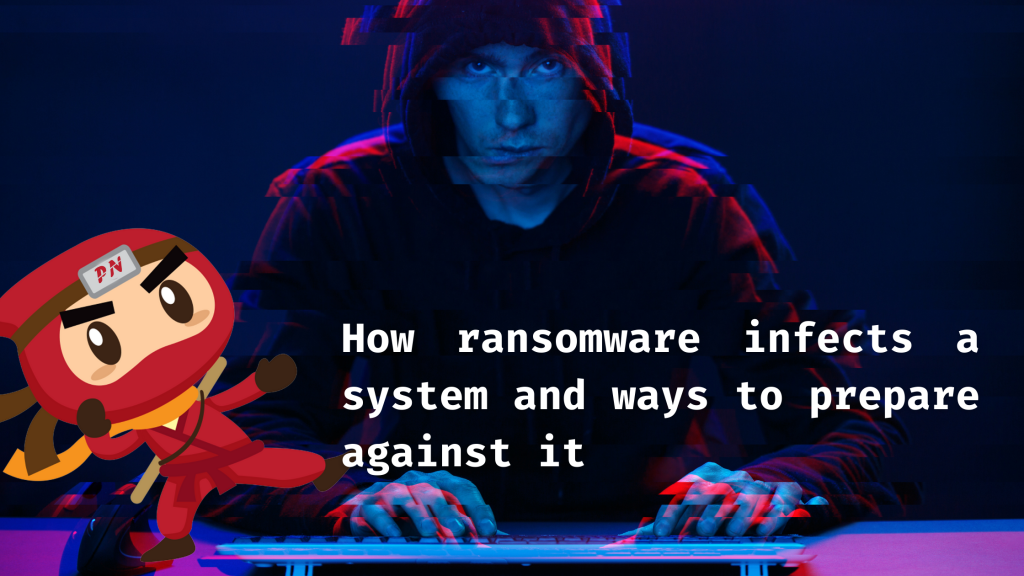
Ransomware is rampant nowadays, especially since businesses are pushed to adopt the digital age. How ransomware infects a system is no longer news, and there are ways to protect you from it. But before that, let’s first define what ransomware is.
Ransomware is a variation of malware (malicious software) that encrypts files and documents. It can infect a single unit of a computer or even an entire network, including a company’s servers. From the word itself, the perpetrator demands a ransom from the victim in exchange for a “decryption key” to regain access.
When ransomware infects a system successfully, the cybercriminals typically provide instructions for communication and the amount to be paid to get the decryption key. Depending on the organization, the cost ranges from thousands of dollars to millions, all paid in Bitcoin.
Most commonly, how ransomware infects system is through phishing scams. In phishing scams, cybercriminals mimic legitimate businesses’ genuine email addresses and contents, and they will send them to unsuspecting victims.
These emails appearing to be genuine has a link or an attachment within them. Once the users click the link or open the attachment, the malware attached to that link or attachment will now take over the victim’s computer, especially when the attachment has built-in social engineering tools that trick users into allowing them administrative access.
Also Read: PDPA compliance for Singapore schools
When ransomware infects a system, it does not affect the users and administrations alone but also the operation of the business. Once there is a successful ransomware attack, the business can be affected as files are by essential files encrypted and cannot be accessed unless the ransom money is paid. However, there is no assurance that the bad actors will do the end of their bargain.
This is why the importance of ensuring a business is protected from any ransomware should be stressed. There are a lot of defensive steps against ransomware an organization can adopt, and the following are some of the practices that these businesses should be practicing regularly:
Maintain backups — thoughtfully
It is recommended to back up your data as this is the most effective way to recover it from a ransomware infection. One should consider putting your backup files in an appropriately protected and stored offline or out-of-band so that it is out of reach to hackers. One could also use cloud services as it retains previous versions of your files, accessible for you to roll it back.
Develop plans and policies
It is always helpful for you to create a response plan for your IT security to use so that they will know what to do when a ransomware event occurs.
Review port settings
A lot of hackers can take advantage of your Remote Desktop Protocol (RDP) port 3389 and Server Message Block (SMB) port 445. Always consider limiting connections to only trusted hosts and consider whether your organization needs to leave these ports open. Always be mindful to review these settings for both on-premises and cloud environments and work with your cloud service provider to disable unused RDP ports.
Harden your endpoints
Always ensure to configure your systems with security in mind. These secure configuration settings can help provide protection from any threat and close gaps concerning security leftover from default configurations.
Keep systems up-to-date
Make sure to keep your devices and machines up to date with all the security updates released from time to time.
Train the team
Train your team on how to respond when ransomware attacks. It is the key to stopping ransomware in its tracks.
Implement an Intrusion Detection System (IDS)
Implementing an Intrusion Detection System (IDS) helps organizations look for malicious activity by comparing network traffic logs to signatures that detect known malicious activity. If there are malicious activities found, IDS will quickly inform you of its presence.
The best way to ensure that your system is vulnerable free from any ransomware attack is to conduct penetration testing. Privacy Ninja can secure your system from vulnerabilities by scanning for potential entry points of bad actors and suggesting solutions to patch it up.
Talk to us, and let Privacy Ninja ensure that your system is threat-free.
Also Read: 3 Reasons Why You Must Take A PDPA Singapore Course
Importance of Efficient Access Controls that every Organisation in Singapore should take note of. Enhancing…
Prioritizing Security Measures When Launching a Webpage That Every Organisation in Singapore should take note…
Importance of Regularly Changing Passwords for Enhance Online Security that every Organisation in Singapore should…
Comprehensive Approach to Data Protection and Operational Integrity that every Organsiation in Singapore should know…
Here's the importance of Pre-Launch Testing in IT Systems Implementation for Organisations in Singapore. The…
Understanding Liability in IT Vendor Relationships that every Organisation in Singapore should look at. Understanding…
This website uses cookies.